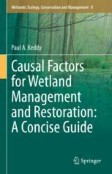Search
Search Results
-
Burial
There are two types of natural burialBurial in wetlands—autogenicAutogenic burial by accumulating peatPeat and allogenicAllogenic burial by...
-
Sedimentary Organic Carbon and Nitrogen Sequestration Across a Vertical Gradient on a Temperate Wetland Seascape Including Salt Marshes, Seagrass Meadows and Rhizophytic Macroalgae Beds
Coastal wetlands are key in regulating coastal carbon and nitrogen dynamics and contribute significantly to climate change mitigation and...

-
Sedimentary phosphorus burial in three contrasting boreal lakes in Finland
Permanent phosphorus (P) burial in sediment regulates lake trophic state over long timescales, but the controls on P burial are only partially...

-
Carbon and Nitrogen Stocks and Burial Rates in Intertidal Vegetated Habitats of a Mesotidal Coastal Lagoon
Coastal vegetated ecosystems such as saltmarshes and seagrasses are important sinks of organic carbon (OC) and total nitrogen (TN), with large global...

-
Patterns and determinants of microbial- and plant-derived carbon contributions to soil organic carbon in tea plantation chronosequence
AimsTea plantation soils have great potential for carbon (C) sequestration because of the perennial nature of tea plants. Long-term tea plantations...

-
Organic carbon in British lowland ponds: estimating sediment stocks, possible practical benefits and significant unknowns
Ponds are aquatic habitats defined by their small size. Although small they are found on every continent, they are disproportionately rich in aquatic...

-
Biocrust and sand burial together promote annual herb community assembly in an arid sandy desert area
BackgroundAnnual herbs are crucial components of sandy ecosystems and their community assembly in arid sandy dunes is an intuitive indicator of a...

-
Sesarmid crabs as key contributors to the soil organic carbon sedimentation in tropical mangroves
The influence of benthic organisms on the turnover rate of leaf litter is considered a vital factor to regulate the dynamic of soil organic carbon...

-
Sediment distribution and organic carbon burial in a subtropical hydroelectric reservoir
Reservoir sediment is a major player in the terrestrial carbon (C) budget, and the quantification of C burial in sediments is important in assessing...

-
Degradation and Preservation of Organic Matter in Marine Sediments
Organic matter that is deposited in aquatic sediments is subject to an intense diagenetic reactor that determines how much organic carbon is...
-
Soil Organic Carbon Sequestration
Terrestrial biomes in the U.S. can be managed for SOC sequestration. Sequestration for climate change adaptation and mitigation occurs when the soil...
-
Benthic Biofilm Potential for Organic Carbon Accumulation in Salt Marsh Sediments
Coastal salt marshes are productive environments with high potential for carbon accumulation and storage. Even though organic carbon in salt marsh...

-
An Improved Framework for Estimating Organic Carbon Content of Mangrove Soils Using loss-on-ignition and Coastal Environmental Setting
The use of loss on ignition (LOI) measurements of soil organic matter (SOM) to estimate soil organic carbon (OC) content is a decades-old practice....

-
Response of soil organic carbon to land-use change after farmland abandonment in the karst desertification control
BackgroundLand-use change caused by vegetation restoration in karst areas plays an active role in soil carbon sink. However, the response of soil...

-
Sources and Cycling of Organic Matter in the Marine Water Column
The organic carbon cycle operates on multiple time scales with a only small fraction of the global reservoir actively exchanged. For the marine...
-
Blue Carbon
The ocean has always been integral to our climate. But human activities such as the burning of fossil fuels has increased the amount of carbon...
-
Controls on the Carbon Isotopic Compositions of Lipids in Marine Environments
Organic carbon isotopes have long been used to study modern and ancient biogeochemical processes. Controls on the isotopic composition of organic...
-
Ecosystem Carbon Stock and Stable Isotopic Signatures of Soil Organic Carbon Sources Across the Mangrove Ecosystems of Kerala, Southern India
Mangrove ecosystems have high carbon storage and sequestration rates and become substantial sources of greenhouse gases when disturbed by land-use...

-
Effects of no-till on upland crop yield and soil organic carbon: a global meta-analysis
AimsNo tillage (No-till, NT), a form of conservation agricultural management, can improve food security and alleviate world climate change by...

-
Overwintering covered with soil or avoiding burial of wine grapes under cold stress: Chinese wine industry's past and future, challenges and opportunities
In northwest China, where winter is extremely cold and the grapevine is vulnerable to freezing damage, the application of soil covering has promoted...

